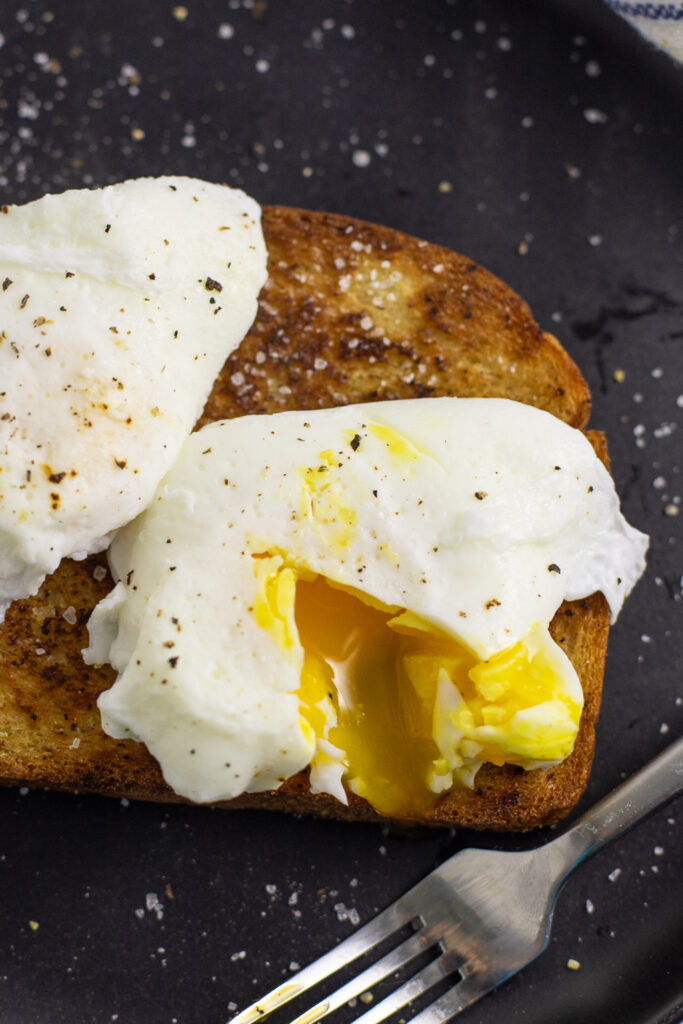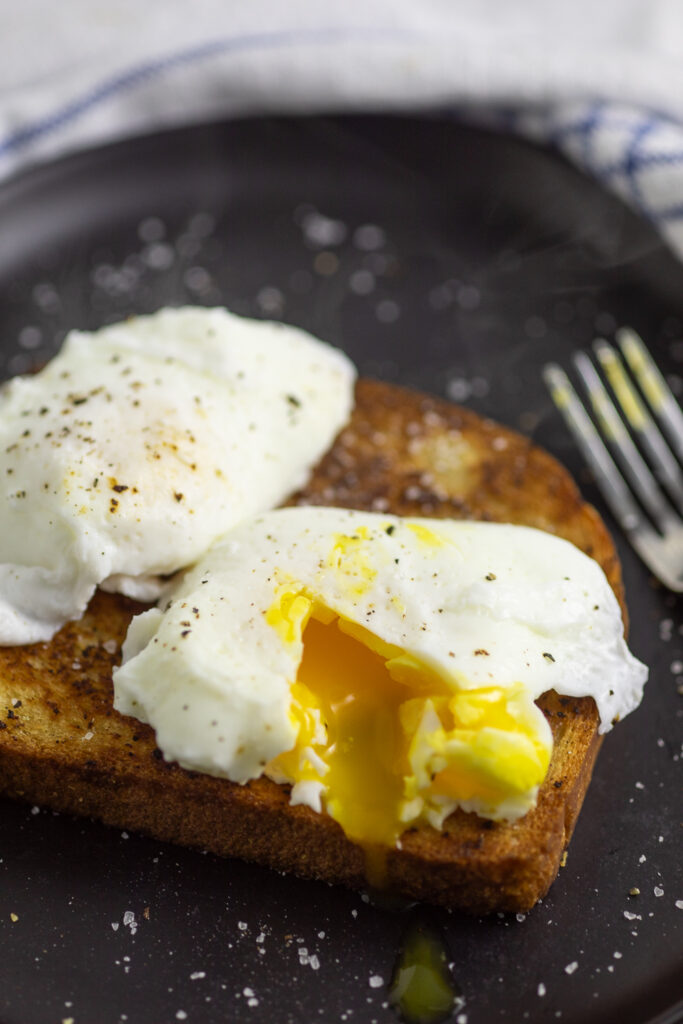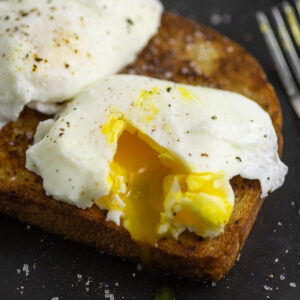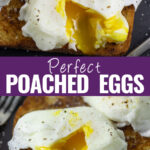Follow this easy and complete tutorial to learn how to make perfect poached eggs with runny yolks and firm whites every time! It's easier than you think!

Perfect Poached Eggs
This epic tutorial has everything you need to make the perfect poached eggs. A perfect poached egg has a creamy, runny yolk and cooked, firm (but definitely not rubbery!) whites.
This foolproof recipe has it all. It's super easy, from boiling water to your plate in just 3 minutes. It requires minimal ingredients, just water, eggs, and a little salt! It's a low-calorie egg cooking method, since no extra fats or oils are necessary. Plus, poached eggs are so versatile, what's not to love?!
What Are Poached Eggs?
A poached egg is simply an egg that has been cooked outside of its shell in boiling liquid.
Fresh versus Older Eggs -- Does the Age of an Egg Matter?
Kind of. As eggs age, the whites become more liquid-y. This will lead to extra whispy pieces during the poaching process. The yolks in older eggs are also more likely to break. Thus, fresh eggs would make the poaching process easier and prettier. The whites and yolks will be firmer and tighter, helping them to stay together and unbroken during the poaching process.
However, finding fresh eggs is not always feasible. After all, grocery store eggs can be up to 60 days old already at the time of purchase, and we don't all have access to a farm. Don't worry! We've got some tips that will help you if you need to use older eggs.

Why Add Vinegar?
Some say that adding vinegar to the boiling water while poaching eggs helps to keep the eggs together. However, in my experience, I've found that it makes the eggs a bizarre texture while also imparting a vinegar flavor, no matter how little you use.
Can I Poach an Egg in a Cup?
No. Technically that would be a coddled egg. A coddled egg is one that is cooked in a cup in hot water, never actually touching the water. A poached egg is cooked directly in the water.
How to Poach Eggs
Finally, let's get down to it. Here's how to poach an egg using three different, easy, foolproof methods.
Using the Easy Method
This method earned its name by being the simplest, hands-off method. No stirring or anything else required.
- Fill a large 10 or 12" high-sided skillet with 2 to 3 inches of water with 1 teaspoon salt.
- Bring to a boil over high heat. Reduce the heat to wherever the water is just below a simmer. You want the water still with no movement.
- Crack an egg into a small separate bowl.
- Gently lower each egg into the hot water, getting the bowl as close to the water as possible to minimize dropping of the egg.
- Cook the eggs for 3 to 5 minutes, then remove to a paper towel-lined plate using a slotted spoon.
Using the Whirlpool Method
This method uses a whirlpool that you create by stirring the water with a spoon. The idea behind this method is that the whirlpool effect lessens the amount of whispy pieces by keeping the egg together in the center of the whirlpool.
- Fill a saucepan (that has a lid) with 2 to 3 inches of water. Add 1 teaspoon of salt.
- Bring the water to a low simmer. (NOT boiling! Adjust your heat source accordingly)
- Crack an egg into a small separate bowl.
- Use a spoon to stir the water in one direction so that it is in motion, like a whirlpool. Stop stirring.
- While the water is in motion, gently slide the egg into the center of moving water. The swirling motion of the water will help prevent the egg white from spreading and will gently wrap the egg yolk.
- Cover the pot and turn off the heat. Let poach for 3 to 5 minutes.
- Use a slotted spoon to remove the egg from the water.
Multiple Eggs at a Time
You can poach multiple eggs at once using the easy method, though I recommend poaching no more than three at once. You'll need a large skillet with a lid, and simply follow the directions of the "easy method," adding up to three eggs in your skillet.
Tips and Tricks
- Using a skillet, no matter the method you're using is easier because it gives you better visibility and more work area.
- Use cold (refrigerated) eggs. Colder eggs are firmer, whereas room temperature eggs are runnier, leading to more whispies.
- For prettier poached eggs, trim off the whispy pieces when it's done cooking.
- Using fresh eggs will help achieve that perfect, buttery custard-like texture you want.
- Make sure the water is fairly shallow (only 1-2 inches) so that the egg has less room to float around.
- Use a timer to ensure you don't overcook the eggs. Remove the eggs from the hot water immediately when the time goes off so that they don't cook extra time.
- Crack eggs into small separate dishes before adding them to the hot water to ensure the yolk doesn't break and make an easier transfer to the water.
- Don't use full boiling water. Use water that is at a low simmer for that perfect delicate texture and an evenly cooked poached egg.

How Long Do You Poach Eggs?
Eggs are usually poached for about 3 to 5 minutes, depending on how firm you want your yolk. Three minutes should yield a firm white with runny yolk, and a 5-minute egg will result in firm whites with a firmer, less runny yolk.
How Can I Tell When Poached Eggs are Done?
The easiest way to know when your eggs are done is by feeling them. Gently lift your eggs from the water with a slotted spoon, and gently feel it. If the egg whites feel too soft and wiggly, it likely needs a little more cook time. If the the whites feel solid and the yolk area feels softer, it's done!
Why Trimming After Cooking is Better than Straining Before
Some recipes recommend straining the egg with a fine mesh strainer before cooking to minimize the whispies around the egg. While this does work, it can also lead to accidentally breaking the yolk while sifting out the excess liquid.
I find it's just as easy and effective to simply trim off the whispy pieces once the eggs are finished cooking.
How to Serve Poached Eggs
There are so many ways to serve poached eggs. They're as versatile and delicious as their fried and scrambled egg siblings. You can serve them the classic way with a piece of buttery toast for dipping and maybe a side of bacon or sausage and fresh fruit. Or you can try one of these other ideas.
- Avocado Toast - Add a poached egg to some toast topped with mashed avocado.
- Salad - add one to a salad for some extra flavor and protein.
- Eggs Benedict - classic eggs benedict are made with a poached egg with a slice of Canadian bacon on an English muffin. Then it's topped with a creamy, tangy hollandaise sauce.
- Burgers - there's nothing better than a runny yolk dripping down a juicy, savory burger.
- Tacos - add a poached egg to classic tacos for some extra creamy rich flavor, or make breakfast tacos with beans, sweet potatoes, and/or avocado.
- Smoked Salmon Bagel - Super elegant, this combo is perfect for an easy brunch. Serve it with or without a little smear of cream cheese.
- Sandwich - Breakfast sandwiches are the perfect vehicle for these perfect eggs. You can also add them to a classic, toasted deli sandwich.
- Grits - These creamy grits are absolutely wonderful topped with a runny egg.
- Oatmeal - Savory oatmeal can be an absolute delight. Add some cheese and scallions along with your eggs and you have a super healthy breakfast packed with protein and fiber.
- Pasta - Make some garlic buttered noodles even better with some protein and creamy, rich runny yolk mixed in.
Perfect Poached Eggs Video

Perfect Poached Eggs
Ingredients
- 6 large eggs
- Water
- 1 teaspoon salt
Instructions
Using the Easy Method
- Fill a large 10 or 12" high-sided skillet with 2 to 3 inches of water with 1 teaspoon salt.
- Bring to a boil over high heat. Reduce the heat to wherever the water is just below a simmer. You want the water still with no movement.
- Crack an egg into a small separate bowl.
- Gently lower each egg into the hot water, getting the bowl as close to the water as possible to minimize dropping of the egg.
- Cook the eggs for 3 to 5 minutes, then remove to a paper towel-lined plate using a slotted spoon.
Using the Whirlpool Method (One Egg at a Time)
- Fill a saucepan (that has a lid) with 2 to 3 inches of water. Add 1 teaspoon of salt.
- Bring the water to a low simmer. (NOT boiling! Adjust your heat source accordingly)
- Crack an egg into a small separate bowl.
- Use a spoon to stir the water in one direction so that it is in motion, like a whirlpool. Stop stirring.
- While the water is in motion, gently slide the egg into the center of moving water. The swirling motion of the water will help prevent the egg white from spreading and will gently wrap the egg yolk.
- Cover the pot and turn off the heat. Let poach for 3 to 5 minutes.
- Use a slotted spoon to remove the egg from the water.
Using the Skillet Method (Multiple Eggs at Once)
- Fill a 12-inch skillet (that has a lid) with 2 to 3 inches of water.
- Add 1 teaspoon of salt to the water.
- Bring the water to a simmer. (NOT boiling! Adjust your heat source accordingly)
- Crack eggs into separate small bowls.
- Gently slide each egg into the simmering water, giving a little space between each egg.
- Cover the skillet and turn off the heat. Let poach for 3 to 5 minutes. Use a slotted spoon to remove the eggs from the water
Notes
- Using fresh eggs will help achieve that perfect, buttery custard-like texture you want.
- Make sure the water is fairly shallow (only 1-2 inches) so that the egg has less room to float around.
- Use a timer to ensure you don't overcook the eggs. Remove the eggs from the hot water immediately when the time goes off so that they don't cook extra time.
- Crack eggs into small separate dishes before adding them to the hot water to ensure the yolk doesn't break and make an easier transfer to the water.
- Don't use full boiling water. Use water that is at a low simmer for that perfect delicate texture and an evenly cooked poached egg.
Nutrition
Never Miss a Thing!
Join our newsletter to get new recipes, tips, tricks, and tutorials every week!






Leave a Reply